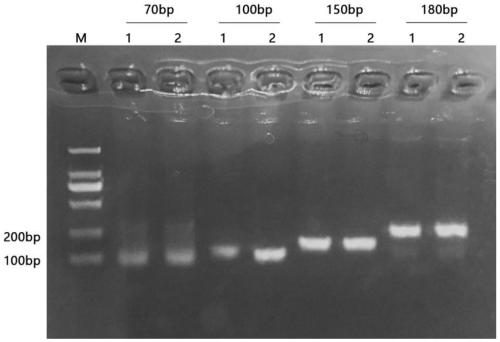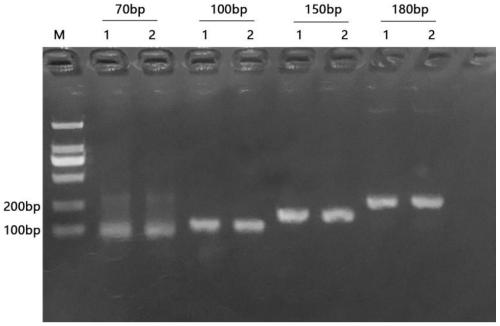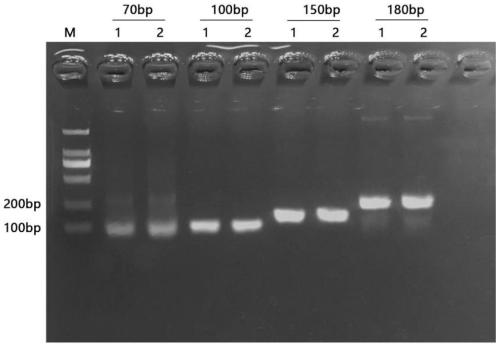High speed nucleic acid amplification method, and equipment and application thereof
A nucleic acid and extremely fast technology, applied in biochemical equipment and methods, specific-purpose bioreactors/fermenters, microbial measurement/inspection, etc., can solve the problem of low efficiency of PCR instruments, affecting work efficiency, and long reaction time and other issues, to achieve maximum flexibility and applicability, save time, and achieve the effect of rapid nucleic acid detection
- Summary
- Abstract
- Description
- Claims
- Application Information
AI Technical Summary
Problems solved by technology
Method used
Image
Examples
Embodiment 1
[0026] Example 1 Preliminary test on the influence of high temperature ambient temperature on the temperature change rate of heating
[0027] Carry out a preliminary test of the influence of ambient temperature on the temperature change efficiency, the specific operation is as follows:
[0028] Set the temperature of the reaction well of the PCR instrument to 100°C, and use a spot thermometer to test the initial temperature of the liquid in the PCR reaction tube as 60°C. Place the reaction tube in the reaction well of the PCR instrument. When the temperature of the liquid in the PCR reaction tube reaches At 92°C, it takes 14 seconds.
[0029] Set the temperature of the reaction well of the PCR instrument to 95°C, and use a spot thermometer to test the initial temperature of the liquid in the PCR reaction tube as 60°C, place the reaction tube in the reaction well of the PCR instrument, and when the temperature of the liquid in the PCR reaction tube reaches At 92°C, it takes 22...
Embodiment 2
[0034] Example 2 Preliminary test on the influence of low temperature ambient temperature on the temperature change rate of cooling
[0035] Carry out a preliminary test of the influence of ambient temperature on the temperature change efficiency, the specific operation is as follows:
[0036] Set the temperature of the reaction well of the PCR instrument to 10°C, and use a spot thermometer to test the initial temperature of the liquid in the PCR reaction tube as 92°C. Place the reaction tube in the reaction well of the PCR instrument. When the temperature of the liquid in the PCR reaction tube drops It takes 4 seconds to reach 60°C.
[0037] Set the temperature of the reaction well of the PCR instrument to 20°C, and use a spot thermometer to test the initial temperature of the liquid in the PCR reaction tube as 92°C, place the reaction tube in the reaction well of the PCR instrument, and when the temperature of the liquid in the PCR reaction tube drops It takes 5 seconds to ...
Embodiment 3
[0043] A preferred embodiment of the comparative experiment of embodiment 3 extremely fast PCR method and routine PCR method
[0044] Four groups of different short fragments of the hepatitis B virus (HBV) gene were used as the target fragments for amplification, and the ultra-fast PCR method was compared with the conventional PCR method.
[0045] 1. The four sets of target amplification sequences and the corresponding forward primer and reverse primer sequences are as follows:
[0046] The first group of target amplification sequences SEQ ID NO: 1:
[0047] 5'-CCCCAACCTCCAATCACTCACCAACCTCTTGTCCTCCAATTTGTCCTGGTTATCGCTGGATGTGTCTGCG-3'
[0048] The first set of forward primers SEQ ID NO:2: 5'-CCCCAACCTCCAATCACTCA-3'
[0049] The first set of reverse primers SEQ ID NO: 3: 5'-CGCAGACACATCCAGCGATAAC-3'
[0050] The second group of target amplification sequences SEQ ID NO:4:
[0051] 5’-CCCCAACCTCCAATCACTCACCAACCTCTTGTCCTCCAATTTGTCCTGGTTATCGCTGGATGTGTCTGCGGCGTTTTATCATCCTTCCTCTTC...
PUM
 Login to View More
Login to View More Abstract
Description
Claims
Application Information
 Login to View More
Login to View More - R&D
- Intellectual Property
- Life Sciences
- Materials
- Tech Scout
- Unparalleled Data Quality
- Higher Quality Content
- 60% Fewer Hallucinations
Browse by: Latest US Patents, China's latest patents, Technical Efficacy Thesaurus, Application Domain, Technology Topic, Popular Technical Reports.
© 2025 PatSnap. All rights reserved.Legal|Privacy policy|Modern Slavery Act Transparency Statement|Sitemap|About US| Contact US: help@patsnap.com



